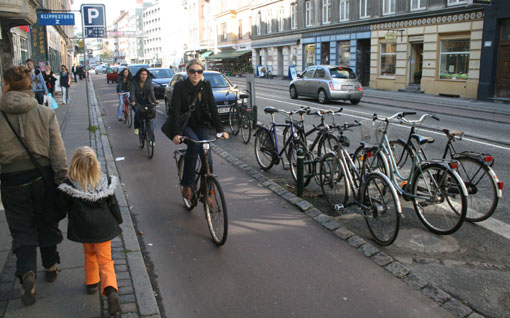Over the years I’ve written a few responses to newspaper columnists who’ve blamed Chicago bike riders for being injured or killed by drivers. But I’ve never written a Streetsblog post in response to a piece by a cyclist who blamed themself after a driver injured them, until today.
Unlike the articles linked above, this is not a call-out of College of DuPage English professor emeritus David McGrath, author of the book “South Siders.” He recently published a mea-culpa op-ed in the Chicago Tribune titled, “I didn’t take wearing a bike helmet seriously. Then a [driver] hit me.” I’m very glad he wasn’t more seriously injured. However, McGrath was way too hard on himself, and way too forgiving of the motorist who struck him, and our car-centric transportation system in general.
According to the article, on a weekday morning McGrath was riding west on a bike-pedestrian side path along a residential street roughly 2.5 miles from his home, presumably in the Chicago suburbs. As he approached a street crossing, the intersection was empty of other vehicles.
However, as he started across the street, to his right he saw a woman in her seventies driving south towards the intersection, where she had a stop sign, McGrath wrote. Instead of stopping, she proceeded through the intersection.
“Midway, I found myself looking into the windshield of a BMW convertible, [whose driver] accelerated and roared forward, as if trying to hit me,” McGrath wrote. “I experienced a split second of hope that I could pedal my bike hard and clear the front of the car. But [the motorist] caught the back end of my bicycle, catapulting me onto the pavement.”
McGrath wound up lying on his back with his bike partly on top of his body. Painting a terrifying picture, he wrote, “My hollering from pain turned to hollering, ‘No!’ as the BMW [driver] swung around and barreled toward me once more. To my immense relief, [she] stopped 10 feet away and the driver got out, holding her phone. ‘What happened?’ I asked. ‘I just didn’t see you,’ she said.”
Her excuse, issued with a “surprisingly calm demeanor,” is even more infuriating when you know that McGrath’s bike had a 7-foot high red flag on the back.
McGrath suffered road rash on his hip, backside, elbow, and knee. Worst of all, he experienced excruciating lower back pain from having his torso wrenched by the impact. He spent six hour at the hospital, where X-rays showed three “vertebral deformities,” but luckily no broken bones. The emergency room doctor also suspected a mild concussion to the cyclist’s head, although his skull didn’t hit the pavement.
Notably, McGrath’s op-ed expressed no anger towards the inattentive, lawbreaking driver who might have killed him. (It’s not clear whether she was cited – McGrath declined comment on the case, citing instructions from his attorney not to further discuss the case.) Instead, in the article he blamed himself for the near-death experience because he wasn’t wearing a bike helmet.
“I used to wear a helmet religiously when I had to ride in traffic,” he wrote. “But when we moved to a neighborhood where I could ride for 45 minutes each morning almost entirely on bike paths, I dispensed with it. Why not enjoy the wind in my hair? Besides, I rationalized, I was probably safer since my peripheral vision was greater without a clunky lid. Both stupid notions nearly got me killed.”
The post you are reading now is not an anti-bike helmet screed. Granted, arguably bike helmets aren’t really necessary for casual commuting or recreational biking at moderate speeds, especially on side paths or in protected bike lanes. Moreover data has shown that high levels of helmet use correlates with dangerous cycling conditions. In the U.S. lots of people bike in helmets and we have a high cycling fatality rate. In Countries like the Denmark and the Netherlands, almost nobody bikes in a helmet, but the cycling death rate is a fraction of ours.
That said, bike helmets certainly aren’t a bad idea in a place like Chicagoland, with subpar bike infrastructure and lots of speeding, distracted, and intoxicated driving. If wearing a helmet makes you feel safer on casual trips, and therefore encourages you to ride your bike more often, you should definitely wear one. (Helmets are certainly a good idea for faster and/or higher-risk types of cycling like road racing, mountain biking, and hauling ass on city streets.) And if you’re going to be involved in a crash where your head hits the pavement or a windshield, it’s of course preferable to have it shielded by shock-absorbing materials.
However, in many types of serious or fatal bike crashes in which a driver runs over a person’s body, a helmet may not do anything to mitigate the damage. And obviously prevention is better than cure – it’s way more important to take steps to stop bike crashes from happening in the first place.
Successful bike crash prevention requires better education and infrastructure. Those elements are certainly key to Denmark’s and the Netherlands’ low bike fatality rate. Universal bike education means that everyone who drives is mindful of cyclists on the road, and probably uses a bike for transportation themself at times. For example, about a third of all trips in Copenhagen and Amsterdam are made by bike. Bike education should be just as common as Driver’s Ed in the States as well.
And, of course, Denmark and the Netherlands is famous for seamless bike infrastructure, and people on bikes are never expected to share the road with fast car traffic. Likewise, Chicago and other local municipalities should build connected networks of protected bike lanes and traffic-calmed side streets, with special attention paid to intersection safety.
But policy is also a key piece of the puzzle. In the Netherlands, it’s understood that operating a multi-ton, high-speed piece of machinery equires a high level of responsibility. So if a driver strikes a person walking or biking, the motorist is automatically held liable unless it can be proved that the victim caused the crash.
If we had such a policy in U.S. cities, motorists like the one who hurt McGrath would less likely to do things like blowing stop signs without checking for bike riders. We should also have require skills testing for driver’s license renewal to ensure that as people age, they still have the reaction time necessary to safely pilot a vehicle that can easily kill people.
“Dumb luck was responsible for my three-point landing and for sparing my unshielded skull,” McGrath wrote. “And it’s dumb luck, I suppose, that I’m alive to write this. You won’t see me without a bike helmet anymore.”
Sure, wear a bike helmet if you want to. But stopping drivers from killing cyclists shouldn’t be a matter of good fortune and a couple inches of Styrofoam and plastic. We need education, infrastructure, and laws to prevent crashes from happening in the first place.





